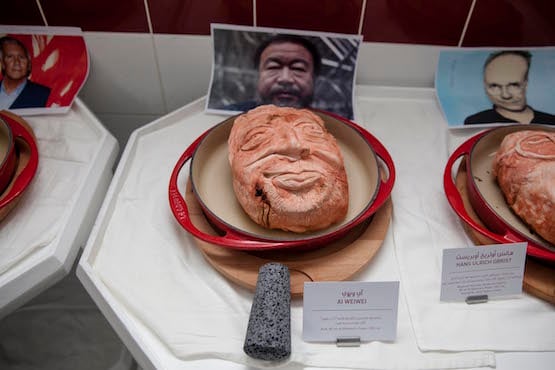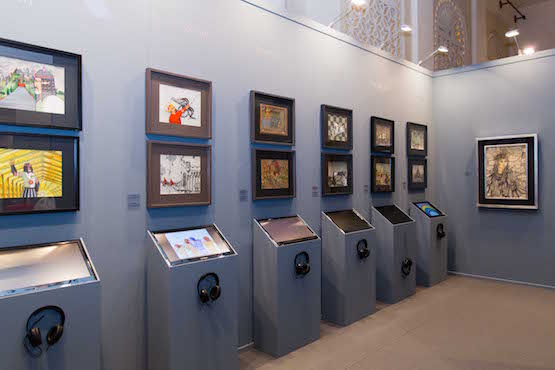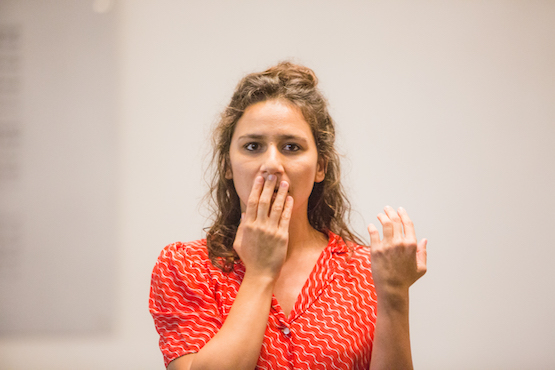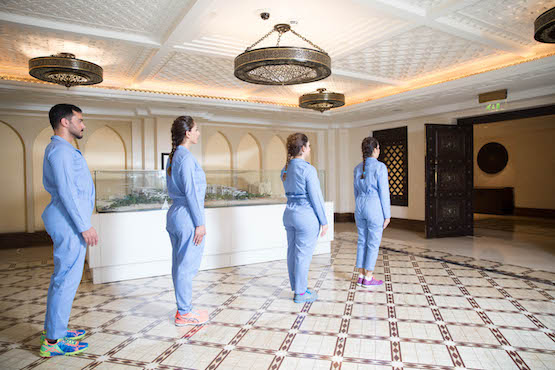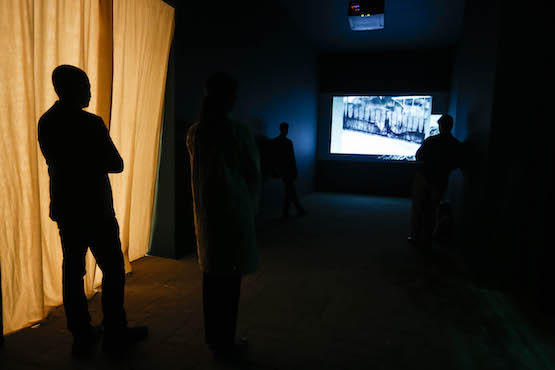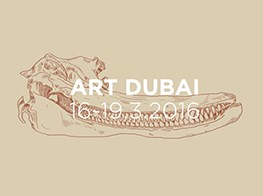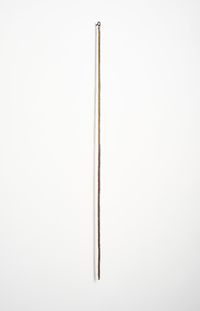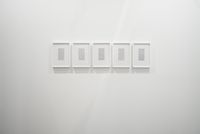House of Love: Art Dubai 2016

Love was out in full force at this year’s Art Dubai—the fair’s tenth anniversary edition, which ran from 16 to 19 March 2016. Much of this was concentrated in a small section of the Mina A'Salam, right next to where Art Dubai Modern was located. Here, The Wedding Project, devised by Delfina Foundation’s Aaron Cezar, staged a nightly dinner offering guests an eleven-course menu designed by past Delfina residents, from Nile Sunset Annex to Candice Lin, reflecting on the eleven stages of love. (Starting with attraction and ending with insanity.)
Image: Aaron Cezar introduces The Wedding Project, 2016. Courtesy The Studio Dubai.Courses included a vegetarian version of the ghastly (and outlawed) ortolan bunting, once a favourite of President Mitterrand, and made by drowning a small live bird in Armagnac before roasting and eating it whole; and the faces of some of the art world’s power 100, from Abramović to Obrist, rendered in dough and baked over chickens, which were smashed open on the night. (I watched Delfina Entrecanales break her own face using the head of a copper pineapple handed to her by Marc Spiegler.)
Image: Candice Lin, "Enslavement" clay-baked chicken, The Wedding Project, 2016. Courtesy The Studio Dubai.The love that framed The Wedding Project—‘a marriage of commissions, interventions, and novel dishes and drinks’—was also present in Art Dubai’s halls and transitory spaces, and not only because the bride and groom, for whom the entire dinner was supposedly planned, ended up wandering the fair instead. Art Dubai’s tenth anniversary was by all accounts a great edition—a testament, as always, to the deft guidance of fair director Antonia Carver, not to mention the ever-poetic offerings of the Global Art Forum, this year co-directed by Amal Khalaf and Uzma Z. Rizvi with Commissioner Shumon Basar. In Art Dubai Modern, the only curated programme of its kind in the world (now entering its third year), the spotlight was shone on a number of notable names, including Adam Henein at Karim Francis Gallery, Huguette Caland and Laure Ghorayeb at Galerie Janine Rubeiz, and Shirin Gallery, who focused on the remarkable works of Ali Akbar Sadeghi, including stills taken from the 1971 animation Seven Cities, which tells the story of an aged warrior on a search for love, and illustrations from a 1970s series aptly titled Love & War.
Image: Shirin Gallery (Tehran, New York) in Art Dubai Modern, exhibiting solo and two-person shows of modern masters of the Middle East, North Africa and South Asia, 2016. Courtesy The Studio Dubai.Art Dubai projects, this year curated by Yasmina Reggad of aria (artists residency in algiers), included a searing performance by Doa Aly (the artist’s first), titled: “free radicals” Dancer Noura Seif expressed movements to Aly’s choreography, inspired by Symptoms of Schizophrenia, a 1940s documentary film, in which patients perform catatonic movements often associated with schizophrenia. These were performed to a soundtrack composed by Alaa Abdullatif, which extracts text from a passage in Daniel Paul Schreber’s Memoirs of My Nervous Illness (written between 1900 and 1903). As Aly mentioned in an interview, the performance links ‘schizophrenia … to a normalised state of “schizophrenic” speech and thought, which characterises our contemporary existence.’
Image: Doa Aly, "free radicals", 2016. Courtesy Daniella Baptista.“free radicals” invokes the madness one can so often feel not only in life and love, but also in an art fair; the kind of schizophrenia that Areej Kaoud, one of the four artists in residence in Art Dubai as part of the A.i.R (Artist in Residence) programme, also curated this year by Reggad, invoked in The Artist Hard at Work, 2016. The performance was produced during the artist’s residency at Tashkeel, and included performers, wearing blue jumpsuits reminiscent of those worn by labourers in the UAE, moving through the fair blowing whistles, and executing movements inspired by workout videos. Indeed, where Aly’s “free radicals” offered an image of affliction (what The Wedding Project called the sixth stage of love), so Kaoud offered an impression of love’s ninth stage—malady, in which the heart turns against itself, becoming its own prison. Such is the madness of desire.
Image: Areej Kaoud, The Artist Hard at Work, 2016. Courtesy Daniella Baptista. The schizophrenia of such emotions, and how they manifest through both individual and collective action was underscored this year at a particularly electrifying Abraaj Group Art Prize exhibition, Syntax and Society, curated by M HKA’s Nav Haq . The presentation featured works by Mahmoud Khaled, Basir Mahmood, Dina Danesh, and a devastating single-channel sound and video installation by the prize’s 2016 winners, Basel Abbas and Ruanne Abou-Rahme, You Can Not See, You Can Not But See. The work is structured around footage taken from an Israeli military surveillance camera, capturing the 2014 death of 14 year-old Yusuf Shawamreh at the hands of the military, just by the separation fence near Hebron, which Shawamreh crossed in order to pick Akub, an edible plant that is a delicacy in Palestinian cuisine.
Image: Basel Abbas and Ruanne Abour-Rahme, You Can Not See, You Can Not But See, 2016. Video installation. Courtesy The Studio Dubai.Abbas and Abou-Rahme, who recently completed their epic project, The Incidental Insurgents, as part of the 2015 Sharjah Biennial curated by Eungie Joo, tempered the urgency and severity of You can Not See, You Can Not But See with characteristic poetics; a tension that was reflected, too, in the balance effected within the two fair halls, across which the Galleries sector is divided. Presence among West and South Asian galleries were strong, with Murat Palka presenting interpretations of Hollywood movies in the 16th century Ottoman miniature style at x-ist, Ali Zanjani and Taraneh Hemami presented at Ag Galerie, as well as a focus on contemporary Iranian art, from Bavand Behpoor to Narges Hashemi at Khak Gallery. Mumbai’s Project 88 featured the wonderful assemblages of trained miniaturist painter Risham Syed—which combine found objects from brass animals to vintage drawers with light features and small paintings—that form part of the A Chronicle Punctuated series. Jhaveri Contemporary presented a stellar line up of artists, including joint pieces created by Iftikhar and Elizabeth Dadi, works by Prem Sahib, Rana Begum and Simryn Gill.
Strong presentations also came from Palestine’s One Gallery, showing Bashar Alhroub and Amer Shomali, Lebanon’s Agial Art Gallery, featuring a range of artists, from Saloua Rouada Choucair to Nathalie Khayat, and Sfeir-Semler, presenting, amongst others, a powerful installation of charcoal drawings paired with printed texts by Haig Aivazian, in Field Drawings (2015). Daniel Templon brought back Sudarshan Shetty, who completes broken fragments of Asian ceramics with wooden finishes, while Espaciovalverde showed young artist Elena Alonso’s works on paper, depicting compositions of abstract places. Meanwhile, Galerie Imane Fares returned with a solid booth with artists from the gallery’s stable, including Ali Cherri and Basma Alsharif, who were also showing as part of Tarek Abou El Fetouh’s excellent exhibition over at the Sharjah Art Foundation, The Time is Out of Joint.
Never failing to add more evolution to a constantly evolving platform, we were told at this year’s opening press conference that the fair floor was composed of 45% women artists; reflective, too, of the strong presence of women in general within the region’s arts infrastructures not only in the UAE, but in the region as a whole. Representation, it seems, is one of Art Dubai’s strong points (this year the fair counted “500 artists representing 70 nationalities, 123 volunteers, 95 visiting museums and institutions, 94 galleries from 40 countries”). Take Marker, a dedicated sector that focuses on a different region or nation each year, launched in 2011 by Nav Haq, and in 2012 offered a focus on Indonesia curated by Alia Swastika. This year, Ringo Bunoan curated a section dedicated to both the artist-run spaces of the Philippines, and its artists, from visionary Roberto Chabet, to younger artists from various artist-run spaces including Post Gallery and 98B, from Tammy David, Wawi Navarroza, to Gail Vincente.
Image: Visitors at Art Dubai Marker, 2016. Courtesy The Studio Dubai. As it has been said before, Art Dubai is a progressive fair—which is why people love it and keep coming back. (A result, too, of the fact that this is one of the only chances so many of us are able to see and meet friends and collaborators in the year.) And though some first-timers pointed out the ‘weirdness’ of it all, no doubt intensified by the increasingly complex hierarchies that define Art Dubai’s social spaces (you might say the Abraaj Group Lounge was eclipsed by the Julius Bar this year), it is an undeniable fact that Art Dubai continues to draw in people and ideas, “From Georgia to Ghana; Palestine to the Philippines,” in a world that needs cultural spaces of knowledge exchange in order to reflect, debate, define, and even counter, the narratives that are currently shaping our present moment. —[O]


